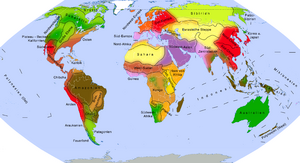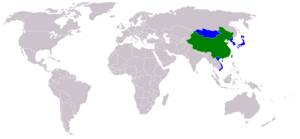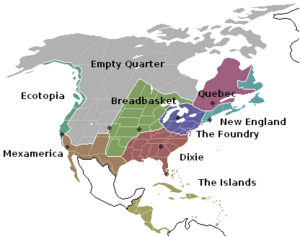Cultural area facts for kids
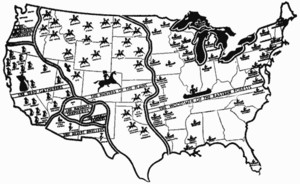
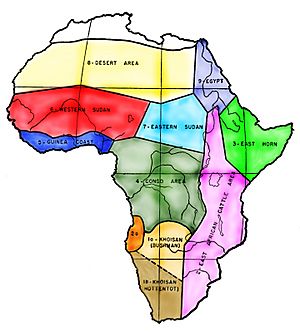
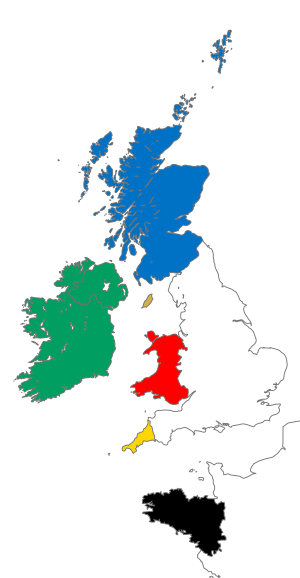
In anthropology and geography, a cultural area, cultural region, cultural sphere, or culture area refers to a geography with one relatively homogeneous human activity or complex of activities (culture). Such activities are often associated with an ethnolinguistic group and with the territory it inhabits. Specific cultures often do not limit their geographic coverage to the borders of a nation state, or to smaller subdivisions of a state.
Contents
History of concept
A culture area is a concept in cultural anthropology in which a geographic region and time sequence (age area) is characterized by substantially uniform environment and culture. The concept of culture areas was originated by museum curators and ethnologists during the late 1800s as means of arranging exhibits. Clark Wissler and Alfred Kroeber further developed the concept on the premise that they represent longstanding cultural divisions. The concept is criticized by some who argue that the basis for classification is arbitrary. But other researchers disagree and the organization of human communities into cultural areas remains a common practice throughout the social sciences. The definition of culture areas is enjoying a resurgence of practical and theoretical interest as social scientists conduct more research on processes of cultural globalization.
Types
Allen Noble gave a summary of the concept development of cultural regions using the terms "cultural hearth" (no origin of this term given), "cultural core" by Donald W. Meinig for Mormon culture published in 1970 and "source area" by Fred Kniffen (1965) and later Henry Glassie (1968) for house and barn types. Outside of a core area he quoted Meinigs' use of the terms "domain" (a dominant area) and "sphere" (area influenced but not dominant).
Cultural "spheres of influence" may also overlap or form concentric structures of macrocultures encompassing smaller local cultures. Different boundaries may also be drawn depending on the particular aspect of interest, such as religion and folklore vs dress and architecture vs language.
Cultural boundary
A cultural boundary (also cultural border) in ethnology is a geographical boundary between two identifiable ethnic or ethnolinguistic cultures. A language border is necessarily also a cultural border, as language is a significant part of a society's culture), but it can also divide subgroups of the same ethnolinguistic group along more subtle criteria, such as the Brünig-Napf-Reuss line in German-speaking Switzerland, the Weißwurstäquator in Germany or the Grote rivieren boundary between Dutch and Flemish culture.
In the history of Europe, the major cultural boundaries are found:
- in Western Europe between Latin Europe, where the legacy of the Roman Empire remained dominant, and Germanic Europe, where it was significantly syncretized with Germanic culture
- in the Balkans, the Jireček Line, dividing the area of dominant Latin (Western Roman Empire) from that of dominant Greek (Eastern Roman Empire) influence.
Macro-cultures on a continental scale are also referred to as "worlds", "spheres", or "civilizations", such as the Muslim world.
In a modern context, a cultural boundary can also be a division between subcultures or classes within a given society, such as blue collar vs. white collar etc.
Specialized terms
Cultural bloc
The term cultural bloc is used by anthropologists to describe culturally and linguistically similar groups (or nations) of Aboriginal peoples of Australia. It may have been coined first by Ronald Berndt in 1959 to describe the Western Desert cultural bloc, a group of peoples in central Australia whose languages comprise around 40 dialects. Other groups described as a cultural bloc include the Noongar people of south-western Australia; the Bundjalung people of northern New South Wales and southern Queensland; the Kuninjku/Bininj Kunwok bloc and the Yolngu cultural bloc in Arnhem Land, Northern Territory.
Examples of cultural areas
Broad dichotomies
- East–West dichotomy: the Western civilization and Western world contrasting with the Orient and Eastern world.
- Global North and Global South: the North–South divide is broadly considered a socio-economic and political divide.
Geographic areas
- Africa
- East Africa
- North Africa
- Maghreb (western and central North Africa)
- Southern Africa
- West Africa
- Americas [see also Americas (terminology)]
- Australasia
- British Isles
- Eastern world
- Indian subcontinent
- Pacific islands:
- Southeast Asia
- Mainland Southeast Asia and Indochina
- Maritime Southeast Asia
Language families
- Aboriginal Australian languages (with many sub-groups)
- Arab world
- Arabic-speaking world
- Celts and Celtic Europe
- English-speaking world (Anglophone)
- Baltic Finns
- Francophonie
- Françafrique
- French America
- German language in Europe
- Hindi Belt (Hindi-Urdu Region)
- Hispanidad
- Hispanic America
- Indigenous languages of the Americas
- Lusophone (Portuguese speakers)
- Mainland Southeast Asia linguistic area
- Latin Europe
- Sinophone (Chinese speakers)
- Slavic Europe
- Russian world
Cultures
- Anglosphere
- Arab world
- Cévennes
- East Asian cultural sphere (Sinosphere)
- Greater China
- Greater India and Indosphere
- Greater Iran (Greater Persia)
- Greater Middle East
- Lusophone
- Nordic countries (speaking North Germanic languages)
- Russian world
Religious beliefs
- Buddhism by country
- Christendom (Christian world), in medieval times referred to as res publica Christiana
- Christianity by country
- Hinduism by country
- Muslim world
- Islam by country
Music
A music area is a cultural area defined according to musical activity. It may or may not conflict with the cultural areas assigned to a given region. The world may be divided into three large music areas, each containing a "cultivated" or classical musics "that are obviously its most complex musical forms", with, nearby, folk styles which interact with the cultivated, and, on the perimeter, primitive styles.
- Europe and Sub-Saharan Africa
- based on shared isometric materials, diatonic scales, and polyphony based on parallel thirds, fourths, and fifths.
- would usually use the natural major scale and minor scale, and Dorian, Lydian and Mixolydian modes.
- North Africa, Southwest Asia, Central Asia, South Asia, Indonesia and parts of Southern Europe.
- based on shared small intervals in scales, melodies, and polyphony.
- would usually use the harmonic minor scale and the Phrygian scale.
- American Indian, East Asia, Horn of Africa, Northern Siberian, and Finno-Ugric music
- based on shared large steps in pentatonic and tetratonic scales.
See also
 In Spanish: Área cultural para niños
In Spanish: Área cultural para niños
- Continent
- Classification of indigenous peoples of the Americas
- Cultural landscape
- Cultural geography
- Cultural tourism
- Culture
- Deep map
- Inglehart–Welzel cultural map of the world
- List of Aboriginal Australian group names
- List of music areas in the United States
- Regionalism (politics)
- Social space
- Sprachbund, a group of languages that share some characteristics
- World language








